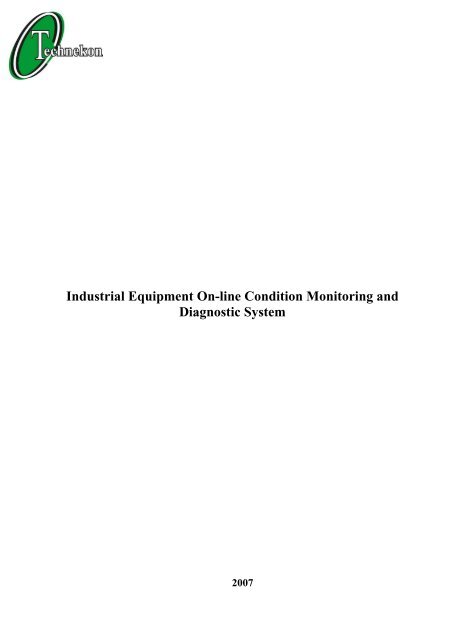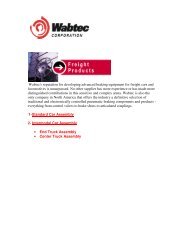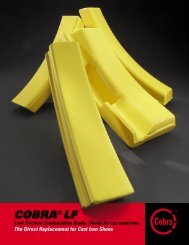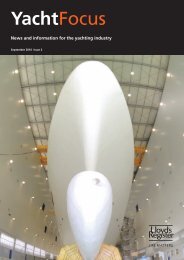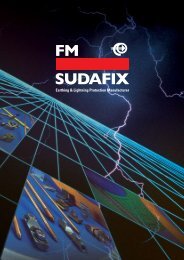Download Brochure. - Rezayat Commercial
Download Brochure. - Rezayat Commercial
Download Brochure. - Rezayat Commercial
Create successful ePaper yourself
Turn your PDF publications into a flip-book with our unique Google optimized e-Paper software.
Industrial Equipment On-line Condition Monitoring and<br />
Diagnostic System<br />
2007
Industrial equipment condition monitoring and diagnostics<br />
Many branches of industry are currently targeted at equipment overhaul-period renewal and<br />
operating expenses reduction. Maintenance expenses form a significant part of total enterprise<br />
expenses and are occasionally comparable to profits.<br />
The most critical and vulnerable industrial units in terms of vibration are rotor devices:<br />
electric motors, compressors, turbines, generators, drives, pumps, etc.<br />
There are three basic maintenance strategies:<br />
- reactive maintenance. In this case no monitoring is applied and maintenance takes place<br />
only after actual failures. This methods leads into significant losses due to equipment downtimes,<br />
required for unforeseen damage elimination.<br />
- routine maintenance. This maintenance type consists from preventive repair works<br />
according to strict schedule. This is routine method and is being used as a primary strategy at<br />
most of enterprises. Unfortunately, routine maintenance, does not allow lowering maintenance<br />
expenses significantly, because at least 50% of repairs are performed without actual need.<br />
- condition monitoring based maintenance. In this strategy actual condition of equipment is<br />
monitored and maintenance takes place exactly when it is actually needed. Online condition<br />
monitoring allows repair work volumes due to methodical suppression of defect causes.<br />
Comparative analysis of different rotor equipment maintenance methods, according to<br />
Machinery Information Management Open Systems Alliance (MIMOSA) data, revealed, that<br />
maintenance cost per unit in energy branch of USA was in 1998:<br />
- $24/kilowatt with reactive maintenance<br />
- $18/kilowatt with routine maintenance<br />
- $12/kilowatt with condition monitoring based maintenance<br />
The main goal of switching to condition monitoring based maintenance is raise of<br />
reliability and lowering of operating expenses. Cost efficiency examples of switching between<br />
routine maintenance and condition monitoring based repairs according to “Bruel and Kjaer”<br />
(Denmark) data for several enterprises is presented in following table:<br />
Annual affordability of switching between routine maintenance and condition monitoring<br />
based repairs:<br />
- Chemicals plant (Machines with rotating units) – Repairs count reduction from 274 to<br />
14<br />
- Petroleum refinery (Electric motors) – Maintenance cost reduction of 75 %<br />
- Paper plant – $ 250,000, (10 times less, than total vibration monitoring equipment<br />
expenses)<br />
- Nuclear power plant – $ 3,000,000 due to maintenance cost reduction, $ 19,000,000 due<br />
to additional profits increase.<br />
Significant worldwide experience of condition monitoring based maintenance<br />
gives following generalized estimate of efficiency:<br />
- Maintenance expenses reduction of 75%;<br />
- Repairs count reduction of 50%;<br />
- Failures count reduction of 70% in first year of operation.<br />
2
Technekon. Condition monitoring hardware and software for industrial<br />
equipment.<br />
Technekon is Russian leading developer and producer of condition monitoring hardware<br />
and software for industrial equipment. During years of work, the company accumulated<br />
significant experience in technologically complex projects achievement.<br />
Today, Technekon has advanced infrastructure, including following sub-units:<br />
• Electronics engineering;<br />
• Software development;<br />
• System engineering;<br />
• Diagnostics;<br />
• Quality control;<br />
• Electronic equipment production.<br />
Technekon produces hand-held devices, allowing a periodic review of the unit followed by<br />
analysis, such as complex enterprise-level control and protection equipment - integrated systems<br />
for continuous monitoring and protection of the plant's equipment (ASTD-2 automated technical<br />
diagnostics).<br />
Where it is necessary to use a continuous monitoring and analysis of the condition of<br />
equipment, we are able to offer systems of every complexity level to be in full compliance with<br />
the technical and economic requirements. System configuration is built strictly in accordance<br />
with the structure of the enterprise and ensures comprehensive protection and analysis of<br />
monitored equipment.<br />
Due to the modular architecture and scalability, the introduction of online monitoring systems<br />
can be done from a simple and low cost option to a completely automated system with a<br />
maximum use of all the features (ASTD-2). ASTD-2 - automated technical diagnosis system<br />
designed for the automation of diagnostic-related personnel activities. ASTD-2 allows operating<br />
of fully automated online monitoring and diagnosis of technical equipment of the entire<br />
Enterprise. Using such systems allows move to maintenance of equipment on it’s actual state.<br />
The quality and reliability of the "Technekon" products can be proved by the fact that for<br />
more than 10 years, one of our regular customers is “Gazprom”, where our automated systems of<br />
technical diagnostics and portable vibration devices have proven to be excellent tools. A large<br />
number of companies use the advantage of our portable systems for the inspection of industrial<br />
units.<br />
On-line monitoring and diagnostics system overview<br />
The on-line monitoring and diagnostic system performs full control of the equipment<br />
condition, timely alerting staff on the changes and providing all necessary information for the<br />
issuance of conclusions on the condition of monitored equipment.<br />
The monitoring and diagnostics system architecture is developed according the enterprise<br />
topology, the composition and characteristics of technological equipment and industrial safety<br />
requirements. At that, premise of a system is the concept of distributed monitoring and<br />
management systems, based on data collection and processing units, integrated into a single<br />
network.<br />
3
CTD-2060<br />
CTD-2160<br />
CTD-3168<br />
Fig.1 Data collection and digital processing units<br />
Online monitoring and diagnostics system, installed at the object consists of following elements:<br />
- primary converters (sensors)<br />
- data collection and digital processing units (Fig.1)<br />
- industry Network RS-485<br />
- server with the appropriate software<br />
- operator workstation with the appropriate software;<br />
- diagnostician workstation with the appropriate software;<br />
- operational documentation set for the system;<br />
- software on appropriate media.<br />
Compiled Outline scheme of the system is shown in Fig 2.<br />
4
Fig.2 Compiled Outline scheme of the online monitoring and diagnostics system<br />
The structure of continuous monitoring and diagnosis system in terms of functions and<br />
topology management of the facility is broken into three levels of the hierarchy performing<br />
appropriate functions :<br />
- aggregate level;<br />
- shop level;<br />
- enterprise level;<br />
Shop and enterprise levels have flexible architecture and allow scaling the system from<br />
simple to complex.<br />
Aggregate level<br />
Aggregate level composition:<br />
− Primary converters (vibration, temperature, pressure, current and other sensors)<br />
5
− Linkage (if necessary)<br />
− Data collection and digital processing units.<br />
Following functions are held at aggregate level:<br />
- direct measurement of the parameters being monitored<br />
- signal processing of measurement results<br />
- vibration level control<br />
- measured and processed data transfer<br />
Figure 3 shows aggregate subsystems for different aggregate types.<br />
t<br />
t<br />
CTD-2160-16<br />
Profibus<br />
RS-485<br />
CTD-2160-16<br />
Profibus<br />
RS-485<br />
Pump type 1 Pump type 2<br />
Pump type 3<br />
Centrifugal compression machine<br />
Reciprocating compressor<br />
Fig.3 Aggregate subsystems example<br />
6
All sensors are connected to data collection and processing units directly or through termination<br />
devices. Due to their size and simplicity of installation data collection and digital processing<br />
units can be installed directly on the machine.<br />
CTD modules are continuously (at intervals of not more than 0.5 seconds) collecting and<br />
processing (RMS calculation and comparison to limit settings in 16 spectral bands) signal from<br />
all sensors simultaneously.<br />
Each band has it’s own warning and alarm setting. Exceeding warning level triggers<br />
alarm informing staff about the need to take maintenance actions. If vibration level exceeds<br />
alarm level, the machine can be stopped automatically. If the machine is stopped - you can view<br />
information on the status of the machine just before the freeze. The time interval of looped<br />
recording is software-configurable.<br />
Data collection and digital processing units functionality:<br />
Control parameters calculation - for each channel up to 16 spectral bands. Length of<br />
cycle is not over 0.5 seconds.<br />
Machine operating mode definition - determined by the speed of the shaft or RMS of<br />
vibration speed<br />
The monitoring and alarm system - regulatory levels of vibration and parameters computed<br />
on vibration comparison.<br />
Shutdowns data ("flight recorder") and the trends collection system - converter records<br />
calculated parameters into trends. The trends collection system is the "flight recorder". The data<br />
continues when the unit is in an operational state and stops when the unit is moving into<br />
"stopped" state<br />
Inspections generation - the module collects waves (wave length collected is between 8192<br />
and 65536 readings) after a command given via RS-485 simultaneously on all channels and all<br />
parameters.<br />
Data exchange with industrial control department – transfer of values of parameters being<br />
monitored via RS-422 interface.<br />
Transferring data to server - through RS-485 with 115200 baud rate.<br />
Table 1. Data collection and digital processing units specifications<br />
CTD-3168 CTD-2160 CTD-2060<br />
Common parameters<br />
Power supply<br />
24 V DC<br />
Power consumption < 8 W < 8 W < 10 W<br />
Initialization delay<br />
< 30 Sec.<br />
Power outage protection<br />
Module configuration is stored in nonvolatile memory<br />
Dimensions 280х206х52.5mm 190х100х81mm 220x145x50mm<br />
Weight 3,25 kg 1,8 kg 3,4 kg<br />
Operating temperature<br />
-40 to +55 С<br />
Humidity<br />
98% at 35 C<br />
Atmospheric pressure<br />
608 – 800 millimeter of mercury<br />
Vibration channels parameters<br />
Input channels 16 vibration channels +<br />
3 tacho-channels<br />
16 vibration channels +<br />
3 tacho-channels<br />
6 vibration channels +<br />
1 tacho-channels<br />
Parameters calculation period 0.1 s 0.5 s 0.4 s<br />
7
Sensors<br />
Status indication<br />
CTD-3168 CTD-2160 CTD-2060<br />
accelerometers,<br />
ICP accelerometers<br />
proximeters<br />
LEDs: "Control",<br />
"Work", "Warning",<br />
"Alert"<br />
LEDs : «Alert» и «Warning»<br />
Vibration speed RMS range<br />
0.1…100 mm/s<br />
Vibratory displacement amplitude<br />
0.1…250 um<br />
FFT resolution 3200 lines 1600 lines 3200 lines<br />
Upper frequency 8 kHz 10 kHz<br />
Lower frequency 0.5 Hz 10 Hz<br />
Maximum number of spectrum bands 12 fixed + 4 adjustable,<br />
for each channel<br />
6 fixed + 10 adjustable, for each channel<br />
Dynamic range<br />
72 dB<br />
Internal noise level<br />
< 4 mV<br />
Bandpass flatness ±2.0 %<br />
Number of tachochannels<br />
Tachochannels parameters<br />
3 tachochannels<br />
(several recordings per<br />
turn)<br />
3 tachochannels<br />
(several recordings per<br />
turn)<br />
1 tachochannels<br />
RPM range 150 - 18000 rpm 180 - 18000 rpm 60 - 18000 rpm<br />
Data transfer speed via RS485<br />
RS485 interface parameters<br />
115 200 bod<br />
Data transfer speed via RS422<br />
RS422 interface parameters<br />
19 200 бод<br />
Number of relays<br />
alarm relay (dry connectors)<br />
4 (Control, Work,<br />
Warning, Alarm)<br />
2 (Warning, Alarm)<br />
Closed state resistance<br />
< 1,5 Ohms<br />
Switched current<br />
Switched voltage<br />
< 0.5 A<br />
200 V<br />
Switched power<br />
10 VA<br />
Shop level<br />
Shop level includes:<br />
− Server, soft hardware unit collecting and storing information received from the<br />
aggregate subsystems, running data processing algorithms, as well as giving users access to<br />
information.<br />
8
− Shift engineer (Operator) workstation, soft hardware unit providing visual monitoring<br />
of technical condition, and alarming on it’s changes.<br />
All information from the modules is automatically transmitted to a server via Profibus RS485<br />
interface (distance from the modules to the server up to 1200 meters without repeaters).<br />
In accordance with the requirements specification software VibroDesigner SCADA gets<br />
fully configured and placed on the server (Server package) and operator’s workstation (Client<br />
package).<br />
The server collects all information from the CTD modules automatically with a period of 1<br />
to 5 seconds. Also server provides storage and data transmission to the operator (online via<br />
Ethernet) and diagnostician (several times a day via Ethernet or e-mail).<br />
Server functions:<br />
• Condition data collecting - data is collected through CTD-modules inquiry with the<br />
period 1 -5 seconds.<br />
• Daily trend generation - with a configurable period of 1-5 sec. the condition data is<br />
written into the daily trend file.<br />
• Automatic generation and storage of shift engineer (operator) reports - a report file of a<br />
coordinated format is generated with data from the CTD-modules.<br />
• Automatic generation and storage of files with inspection data - an inspection file is<br />
generated for all working units in the shop on data from the modules.<br />
• Automatic generation and storage of data files for diagnostician reports - a file with the<br />
data for the diagnostician report is generated for all plant units using the data obtained<br />
from the CTD-modules of the shop.<br />
• Automatic generation and storage of data files for aggregates shutdowns – When the<br />
state of the unit changes from "Work" to "Stop" a single file with the shutdown report is<br />
generated.<br />
• Automatic data files transfer to diagnostician workstation - pre-stored data files (files<br />
with inspection data, diagnostician reports data files and shutdowns records files) are<br />
being sent to the diagnostician workstation. Files are sent either via through e-mail or<br />
over LAN.<br />
Operator workstation<br />
All the information is being transferred to the operator’s workstation in accordance with<br />
the system configuration. The display shows the condition of all units; the parameters for each<br />
unit can be monitored at each location (not only the overall level, but by bands, absolute and<br />
relative), a families of band trends (daily trends), run-outs. In case of exceeding the limit, color<br />
alarm indication is shown making rapid determination of the point exceeded allowed levels.<br />
There is also an opportunity to create and print reports.<br />
Operator Panel consists of the equipment generalized state display area and the three<br />
main screens ("shop", "Aggregate", "Trends"), there is also the possibility of opening an<br />
additional window for viewing and printing shift engineer reports.<br />
9
Fig 4. Operator Panel. “Shop” screen<br />
Fig.5 Operator panel “Aggregate” screen<br />
10
Fig. 6 Operator reports window<br />
Enterprise level<br />
Enterprise level includes:<br />
− Diagnostician workstation, soft hardware unit, providing detailed analysis of<br />
diagnostics data about technical condition of units<br />
Ethernet and TCP/IP are used for the connection to the server.<br />
All the information automatically passed to diagnostician’s workstation several times a<br />
day (defined at system configuration) and remains in the database, according to the structure of<br />
the enterprise. Diagnostician software installed at workstation (“VibroDesigner standard”) allows<br />
performing a detailed analysis of the condition of the units and making conclusions on the units<br />
condition and generate reports.<br />
Diagnostician workstation functions:<br />
• Real time data view - you can switch from viewing archived data to real-time viewing of<br />
data.<br />
• Automatic inspections and diagnostician reports recording into diagnostic database –<br />
file, obtained from the server and saved through automatic processing are automatically<br />
recorded into diagnostics databases.<br />
• Diagnostician report viewing – diagnostician report contains information on the status of<br />
the plant during the past day and enables rapid detection of units with the changed<br />
conditions.<br />
• Databases archiving – the data is archived for the creation of a single archive of<br />
diagnostic data for the entire period of operation of the park equipment.<br />
11
• Failure location and causes identifications – our software “VibroDesigner”allows<br />
extensive Graphical analysis of the inspection data.<br />
Fig. 7 Visual analysis in “VibroDesigner Standard” software<br />
12
Example 1. Server and operator’s workstation is installed in each shop’s operating room. Data for further analysis and making conclusion about<br />
equipment condition is transferred over enterprise LAN to the integrated diagnostics department.<br />
13
Example 2. Condition information for each unit monitored is transferred t the integrated operating room, where serve, operator’s workstation and<br />
diagnostician’s workstation are installed.<br />
14
Example 3. If there are several objects included in the enterprise, equipment condition information is automatically transferred to common remote<br />
diagnostics center. At each object server and operator’s workstation is installed either at each shop or at the integrated operating room.<br />
15


